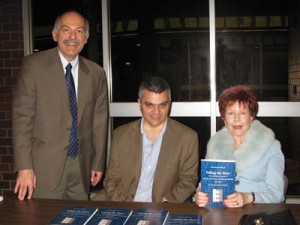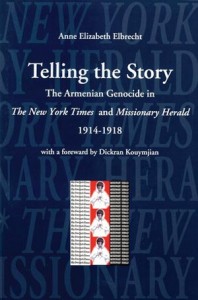Denise Altounian
Staff Writer

Did the world know that the first Genocide of the 20th century was taking place when it was actually happening? Who was willing to help? Was there media coverage? As an Armenian-American these questions cross my mind whenever I think of the Armenian Genocide, and on Thursday, March 29th some of these questions were answered.
Prof. Barlow Der Mugrdechian, Coordinator of the Armenian Studies Program, welcomed Ara Sarafian (London) and Anne Elizabeth Elbrecht (Davis) for a lecture that shed new light on the American media response to the Armenian Genocide.
Elbrecht spoke on her newly published book, Telling the Story: The Armenian Genocide in The New York Times and Missionary Herald 1914-1918, based on her Master’s thesis completed at California State University, Sacramento.
Elbrecht explained how the Armenian story was introduced to the American public. The book fills in missing gaps, which were not previously known about. She was joined by Sarafian, the director of the Gomidas Institute in London, England, who published Telling the Story.
Sarafian, an archival scholar specializing in late Ottoman and modern Armenian history, added his historical expertise to the lecture. The overall theme of the night was just how important this work, the documentation of media coverage, is for the Armenian community.
Often we hear about the events of Genocide from eyewitness accounts, but rarely do we hear it mentioned through media coverage. As it turns out, the American newspapers played a crucial role in informing the world and motivating them to help. According to Sarafian, Americans should be proud of the effort that was mounted to help the victims of the Armenian Genocide-humanitarian efforts, some of which were started as early as October 1915, by the Near East Relief.
 The book documents the Genocide coverage of two newspapers: The New York Times and the Missionary Herald. Most Americans were not aware of Armenia, and it was The New York Times, the preeminent newspaper in the United States in the early 1900’s, that introduced the public to the Armenian relief efforts and encouraged its readers to donate. The less familiar Missionary Herald communicated to supporters from the perspective of Protestant ministers who were working in the Ottoman Empire and Armenia at the time.
The book documents the Genocide coverage of two newspapers: The New York Times and the Missionary Herald. Most Americans were not aware of Armenia, and it was The New York Times, the preeminent newspaper in the United States in the early 1900’s, that introduced the public to the Armenian relief efforts and encouraged its readers to donate. The less familiar Missionary Herald communicated to supporters from the perspective of Protestant ministers who were working in the Ottoman Empire and Armenia at the time.
Elbrecht has spent the last twenty-five years traveling to Turkey with her husband, Richard, to document the churches of historic Armenia, and gain more insight on her thesis. Over the years the Elbrechts became acquainted with the Armenian culture and fell in love with the Armenian churches.
The Elbrechts took many photos on their trips, and organized 157 high quality ones of Armenian churches, which now serve as an important documentation of Armenian history. These photos have been displayed at various conferences all over the world, and have generously been donated to the Armenian Studies Program at Fresno State.
The photos are part of the exhibition, “Churches of Historic Armenia: A Legacy to the World,” on the Armenian Studies Program website at http://armenianstudies2.fresnostate.edu/resources/churches/index.shtml. The lecture concluded with a brief visual tour of the new website for the audience.
It was clear to see just how important the Elbrecht’s work is for future research on the Armenian Genocide.
 Hye Sharzhoom Armenian Action
Hye Sharzhoom Armenian Action